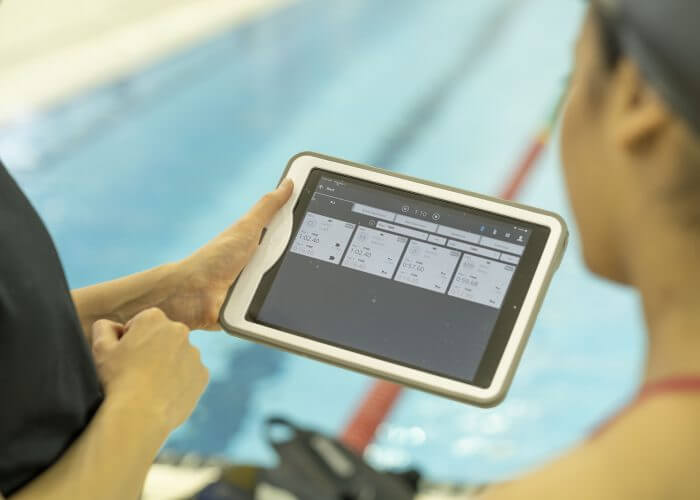Better Swimming Through Technology; Tracking Performance
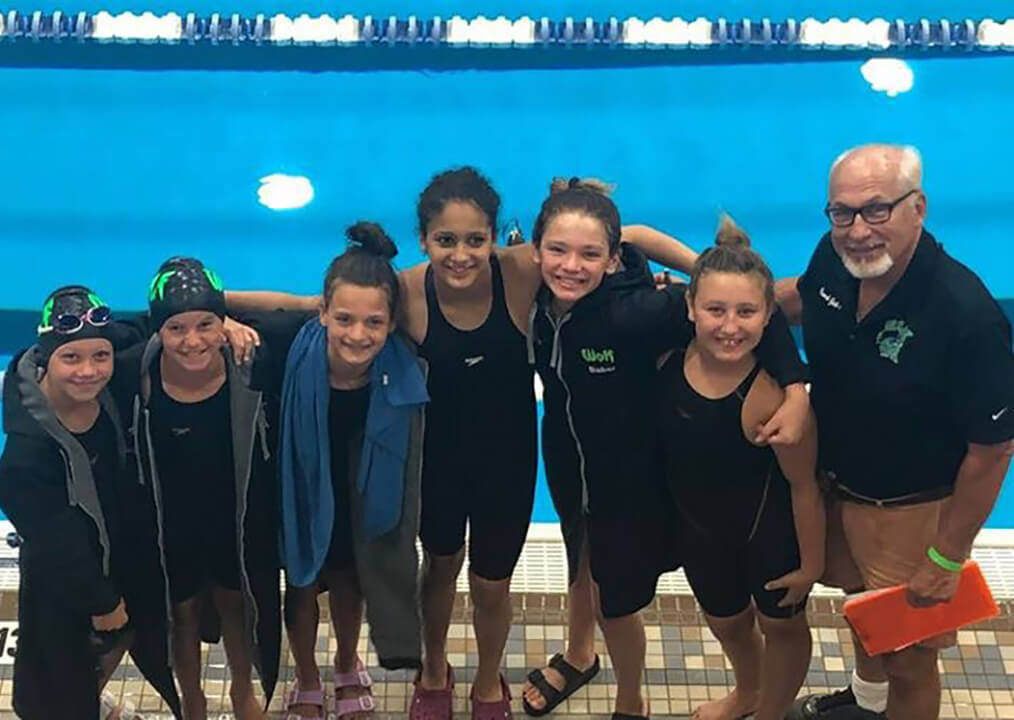
John Thomas, currently head age group coach at Great Wolf Swim Club in Spring Lake Park, Minn., has a passion for recording times and using data to maximize swimmer performance. In summer 2017, Great Wolf purchased 10 TritonWear units. Since then, Thomas has become a huge proponent of this advanced swimming technology, an artificial intelligence-based coaching tool produced by a firm in Toronto, Ontario.
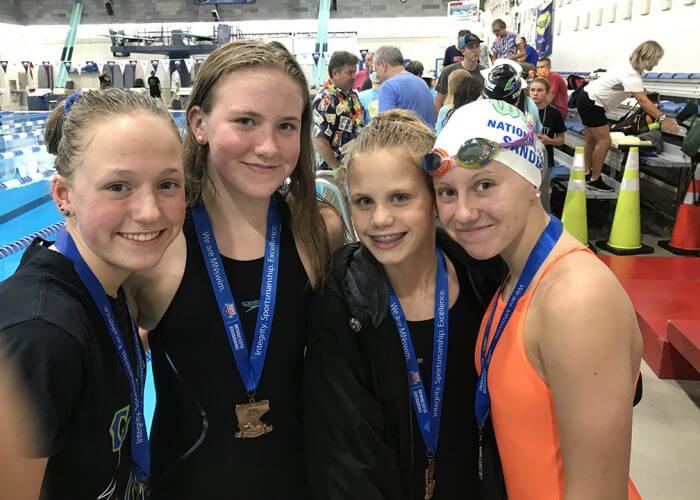
With TritonWear, swimmers track training, diagnose weaknesses, and monitor progress; Photo Courtesy: Great Wolf Swim Cub
The company’s latest hardware iteration, the Triton2, is a great complement to its comprehensive swim analytics platform that tracks 13 different metrics based on swimmer motion. The metrics include splits, stroke rates, index and speed, DPS, time in breakouts, turns and underwater. In short, the information recorded in a small unit placed inside a swimmer’s cap, is transmitted immediately to an iPad. This data gives coach and swimmer the ability to track training, diagnose weaknesses and monitor progress. Additionally, motion analysis software syncs video with the power of acceleration and speed data. The resulting frame by frame output clearly indicates which movements help a swimmer gain or lose speed within their strokes and skills.
Pricing is an annual per athlete subscription, ($188 USD, volume discounts available) and includes all TritonWear swimming technology tools plus one free Triton 2 unit.
The Great Wolf Experience
Thomas was a conference champion sprinter at Gustavus Adolphus College. In a coaching career interrupted by forays into the business world he has managed to coach three Edina High School girls teams to state championships. His highest profile athlete, among many, was Lori Heisick, 17x All-American (Stanford) and 7x National Team member who set the national high school in the 100 breaststroke record and finished third at 1988 Olympic Trials.
These days Thomas coaches Great Wolf’s junior elite squad that includes the team’s top 11-14 year olds. Most are champion swimmers, holding times of AAA or better. He reports that almost 25 % are zone qualifiers. He has been collecting information on his swimmers for more than 2 years now and the resulting data has given him a substantial knowledge base on which to establish future training.
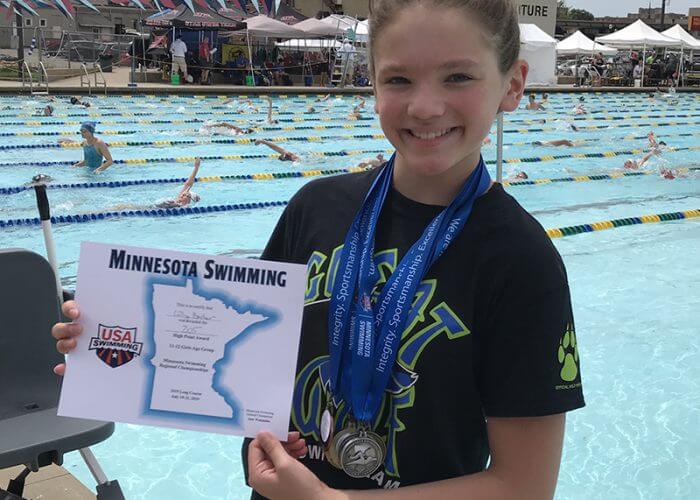
USA Swimming High Point Award for Wolf Pack Swim Club swimmer, Lilly, in 11-12 Age Group; Photo Courtesy: John Thomas
“I’m not a huge fan of over distance swimming,” he says. “I want speed first and then work on conditioning. And I do have my swimmers do some USRPT training. Swimmers have to find out how to deal with the increased speed and eliminate drag. Stroke technique is another big part of our training for all strokes.
“I’ve been interested in new equipment and technique my entire career. With Tritonwear the information gathering has been much easier, giving both coach and athlete insights into performance never before available,” says Thomas.
“I believe coaches and athletes are missing some real opportunities by not embracing this technology. When I’ve talked with some coaches about this product they indicate interest but usually don’t go any further. Many are set in their ways and don’t see the need to keep track of this type of information. They feel the hassle of having swimmers wear the units and the monitoring is too great. Their attitude seems to be ‘when I leave practice I’m done’ and they are unwilling to invest the time to keep track of the data.
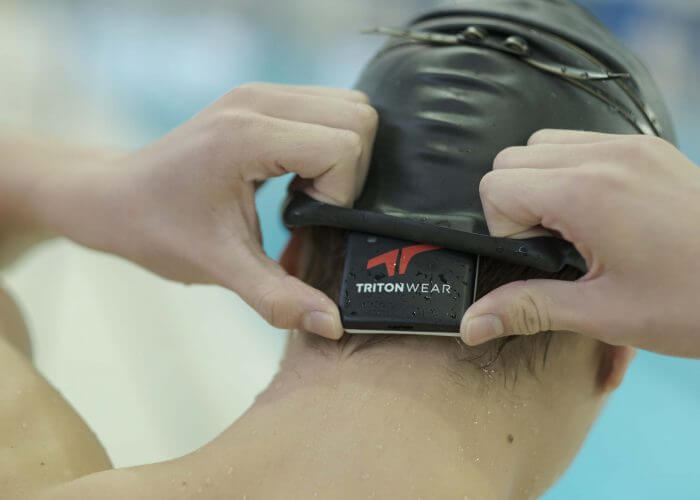
“What I like is that the units force the swimmers to be accountable to what they do in the pool,” says John Thomas of the TritonWear unit.
“With some swimmers it is the same. They know they are monitored, but only a few take the time to look over their data. While they are focused in the pool, once they are finished they are also done and don’t want to bother with anything further. My hope is that current TritonWear users who don’t bother to review their data will want to look at it at some time in the future.
“After 24 months my observation is that the top 10% of swimmers will improve because of talent and training. This group may not need the TritonWear units as much as the next 20-30%. I am convinced TritonWear metrics for those swimmers will results in faster times and stroke improvement. And it is from this group, by accessing any of the 13 different metrics tracked by TritonWear, that may come swimming’s next big star.”
In the Beginning
“Initially the units floated from one swimmer or another and were not assigned to a particular profile. At the end of practice I would tell a swimmer to go to a particular email to which the unit had been assigned and view their workout. That was cumbersome. Now I’ve now got 8 swimmers who have their own profile and their workout goes directly to their own email,” he says.
“In practice now I hand out the units. With them, swimmers know they are being monitored and we get an exact record of their practice performance. That’s something we would not have if we didn’t have the units. What I like is that the units force the swimmers to be accountable to what they do in the pool — on every set and each length. If they decide to take it easy on some workout portion the data will reflect it. And I’ve seen better engagement by swimmers when they are wearing a unit,” says Thomas.
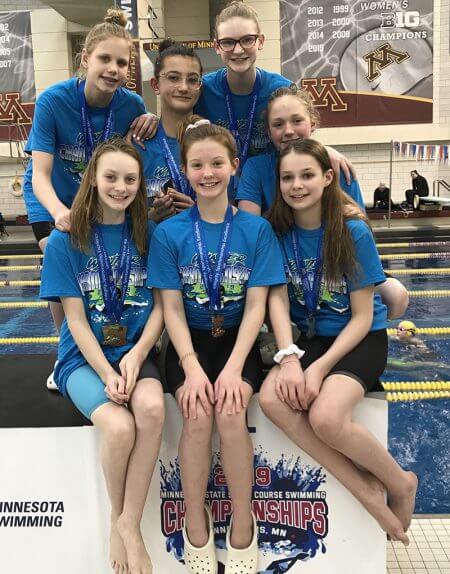
Head Age Group coach uses TritonWear swimming technology to help get these athletes to the medal stand; Photo Courtesy: Great Wolf Swim Club
“When we first purchased TritonWear, I was most interested in the record of all the tracked metrics. Stroke rate and DPS are not easy to follow during most workouts. TritonWear does it for us. Many times you may ask a swimmer to work on these two things. Over the course of the workout they may forget about them. With this tracking swimmers know if they put effort into it the metrics will register it.
“It is easy to set time goals. We talk to swimmers specifically about improving their TritonWear metrics to reach those ends. For example, if a swimmer’s DPS goes up and their times haven’t, it may be because of a heavy training load. However, once rested and stronger and because of a greater DPS, they may get faster and show time improvement.
“To help me track swimmer progress and explain results I assemble the TritonWear data into spreadsheets. That allows me to compare a set done today with one done previously and see how, and if, things are changing. The TritonWear software indicates that in most in most cases swimmers are getting faster. It would be very difficult to do the time recording on so many metrics without using the units.
“I have a math professor friend at nearby Macalester College. He notices that many students, not just math majors, are applying statistical principles to their particular majors. He asserts that statistics are the future and will be needed in everything we do. I am certainly a believer in how that applies to swimming,” says Thomas.
